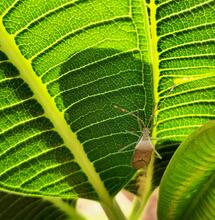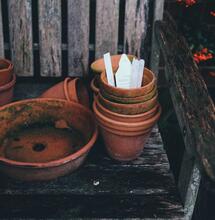Prevent Diseases and Pests

Clean well-maintained gardens have few problems with diseases and pests. In contrast, every dingy, dank, ill-kept garden I have seen had problems with powdery mildew, bud rot, spider mites, thrips, and many more diseases and pests. Problematic gardens yield substandard harvests.
Prevent diseases and pests by controlling the things that attract diseases and pests and help them multiply. Remove dank unsanitary hiding places. Wear clean clothes. Wash your hands and tools after touching diseased plants. If diseases attack one or a few plants, isolate and treat them separately. [caption id="attachment_39533" align="alignnone" width="1920"] Large outdoor plants that are strong and healthy do not get diseases and pests.[/caption] Keep your garden clean. Sweep the floor and sidewalks daily. Cover dirt pathways with woven cloth weed barriers to minimize dust and mud and facilitate cleaning. Sanitize enclosed garden floors, walls, containers, etc. with a 5 percent bleach solution. Use clean organic mulch – straw, alfalfa hay, well-rotted compost, etc. – outdoors that is disease and chemical free. Do not use tainted cannabis leaves or other diseased and pest-laden mulch. Indoors and in greenhouses use mulch that can be sterilized including expanded clay pellets, paper and plastic. Gardeners transport many diseases and pests that could destroy their gardens. Simple regular sanitary precautions will exclude diseases and pests. Wear clean clothes – shirt, shoes, pants, gloves – especially in enclosed areas. These simple precautions keep the problems outside garden walls. Set a tray of dilute 5 percent bleach solution outside the garden to sterilize shoes. Step in the solution each time you enter the garden. Professional medical cannabis growers use this successful technique to keep diseases and pests from entering their indoor and greenhouse gardens. [caption id="attachment_39534" align="alignnone" width="1920"] The layer of straw protects roots in SmartPots from extreme heat and water loss.[/caption] Wash your hands at least 20 seconds with soap and warm water before touching foliage and after handling diseased plants. Apply few drops of rubbing (isopropyl) alcohol to hands for quick sanitation in between handling diseased plants. Washing your hands kills bad bacteria, fungi and viruses. Diseases and pests ride from plant to plant on dirty tools, containers and other supplies. Disinfect tools and supplies by dipping or wiping with rubbing alcohol, 5 percent bleach solution, commercial disinfectant or sterilized with a hand-held torch to kill any diseases and pests. A quick heating with the torch will sterilize tools in a few seconds. Separate sets of indoor, greenhouse and outdoor tools and supplies are much easier to keep clean. [caption id="attachment_39535" align="alignnone" width="1920"] A tunnel greenhouse overgrows rows quickly. The crop has to be fast so that no diseases and pests have time to move in.[/caption] Remove sick plants in containers from the garden and treat in issolation. A single weak and sick plant can spread devastating problems in gardens quickly. If unable to issolate plants, consider removing them and destroying if problems are serious. [caption id="attachment_39536" align="alignnone" width="1920"] This big greenhouse has lights to keep plants in vegetative growth.[/caption] Soil-borne diseases and pests and their eggs live in tainted used potting soil and soilless mixes of containerized plants. Used growing mediums compact and texture degrades. Roots penetrate compacted growing mediums more slowly and there is less room for oxygen, which restricts nutrient uptake. Used potting soil is depleted of nutrients and has nutrient imbalances. Undernourished plants grow in disease-prone growing mediums. These sickly plants are perfect targets for disease and pest infestations. Avoid problems. Throw out used growing mediums or incorporate them into outdoor garden soil. Saving a few dollars on potting soil will be repaid with a diminished harvest and lost crops. Starting a new crop in new growing medium will cost more up front but will eliminate many potential problems. [caption id="attachment_39537" align="alignnone" width="1920"] These plants will be transplanted outdoors.[/caption] Replacing soil and other substrates can be cost-prohibitive in big gardens. Reusing soil requires extra labor and techical know-how. Air ventilation is essential in all gardens, indoors outdoors and greenhouses. Indoors and in greenhouses, passive ventilation is the easiest and least expensive humidity control. Open passive intake and exit vents to create natural airflow using a simple physical principal – hot air rises. Intake vents located near ground level bring in cool air that is drawn out exit vents located near the ceiling. [caption id="attachment_39539" align="alignnone" width="1440"] Big pots grow big plants[/caption] Indoors a vent fan attached to a humidistat is often the most effective form of humidity control. I have visited garden rooms and greenhouses with poor ventilation, some with no extraction fans. The humid stagnant air was so overpowering it caused my glasses to fog. The solution is simple, install a vent fan to suck out moist-stale air. Install vent fans large enough to remove moist air quickly and keep humidity at 50 percent or less. Connect CO2 generators and emitters to a controller that manages air extraction. CO2 generators increase cannabis growth, but create heat and humidity as byproducts. Dehumidifiers are relatively inexpensive, readily available and do a good job of keeping humidity under control in enclosed areas. Dehumidifiers draw extra electricity and the condensed water must be removed daily. Most air conditioners can be set to a specific humidity level. Wood, coal and electric heat all dry and dehumidify the air. Open home heat and air conditioner vents that are located in indoor gardens to help control temperature and lower humidity. [caption id="attachment_39540" align="alignnone" width="1920"] A selfie in front of a very productive garden in California.[/caption] Outdoors, lowering humidity requires planning. Plant in areas with natural air flow such as breezeways and hillsides. Do not plant at the bottom of a canyon or valley where air hangs and stagnates. Once plants are in the ground, humidity is virtually impossible to control. Containerized plants can be moved to locations with natural air flow if weather changes. Air circulation makes life miserable for diseases and pests. Many pests are literally blown away in the wind. Fungal spores have little time to settle in a breeze and grow poorly on wind-dried soil, stems and leaves. Set up air circulation fans indoors and in greenhouses. Prune and remove spindly branches and foliage inside plants. This will increase air circulation within plants so that stagnant air can be evacuated efficiently. All plants indoors, in greenhouses and outdoors benefit by removing low-value foliage. Plant insect- and fungus-resistant varieties of cannabis. In general, cannabis indica-dominant varieties are most resistant to pests and sativa-dominant are more resistant to fungal attacks. Choose mother plants that you know are resistant to diseases and pests. Disease and pest resistence are just starting to become a priority among professional breeders. To date, few disease and pest resistent varieties are available. This is another reason sanitary growing techniques are essential to shield plants from these garden-wreckers. Employ all of these preventative measures and your garden will have fewer problems with diseases and pests. And, when disease and pest problems arrise, they will be much easier to pinpoint and correct. Preventing diseases and pests from getting started is much easier than wiping out an infestation. If diseases and pests are left unchecked, they can devastate the garden in a few short weeks. Enclosed indoor gardens are more prone to diseases and pests because they offer a hospitable environment for cannabis-destroying diseases. Totally enclose (seal) garden rooms so that the environment can be controlled efficiently. A little negative pressure in sealed garden rooms makes life difficult for diseases and pests. [caption id="attachment_39541" align="alignnone" width="1920"] Although more expensive and problematic, growing indoors is still popular.[/caption] Greenhouses heat up when the sun comes out and cool quickly when the sun goes away. The temperature can rise beyond the safe threshold of 29 degrees C quickly. High temperatures retard growth and cause many other problems. When temperatures drop, relative humidity climbs rapidly causing condensation to form everywhere – walls, foliage, soil, etc. Outdoor gardens are my favorite! They are less prone to diseases and pests because natural forces – sunlight, wind, rain and natural predators – keep diseases and pests in check. Control diseases and pests. If prevention proves inadequate and diseases appear, methodical control measures will be necessary. Diseases can spread like wildfire if the conditions are right. If diseases take hold, even after all preventative measures are taken, take immediate action. Identify the disease or pest the damage caused. Assess the scope of the plague. Next, take action to control.



.png)